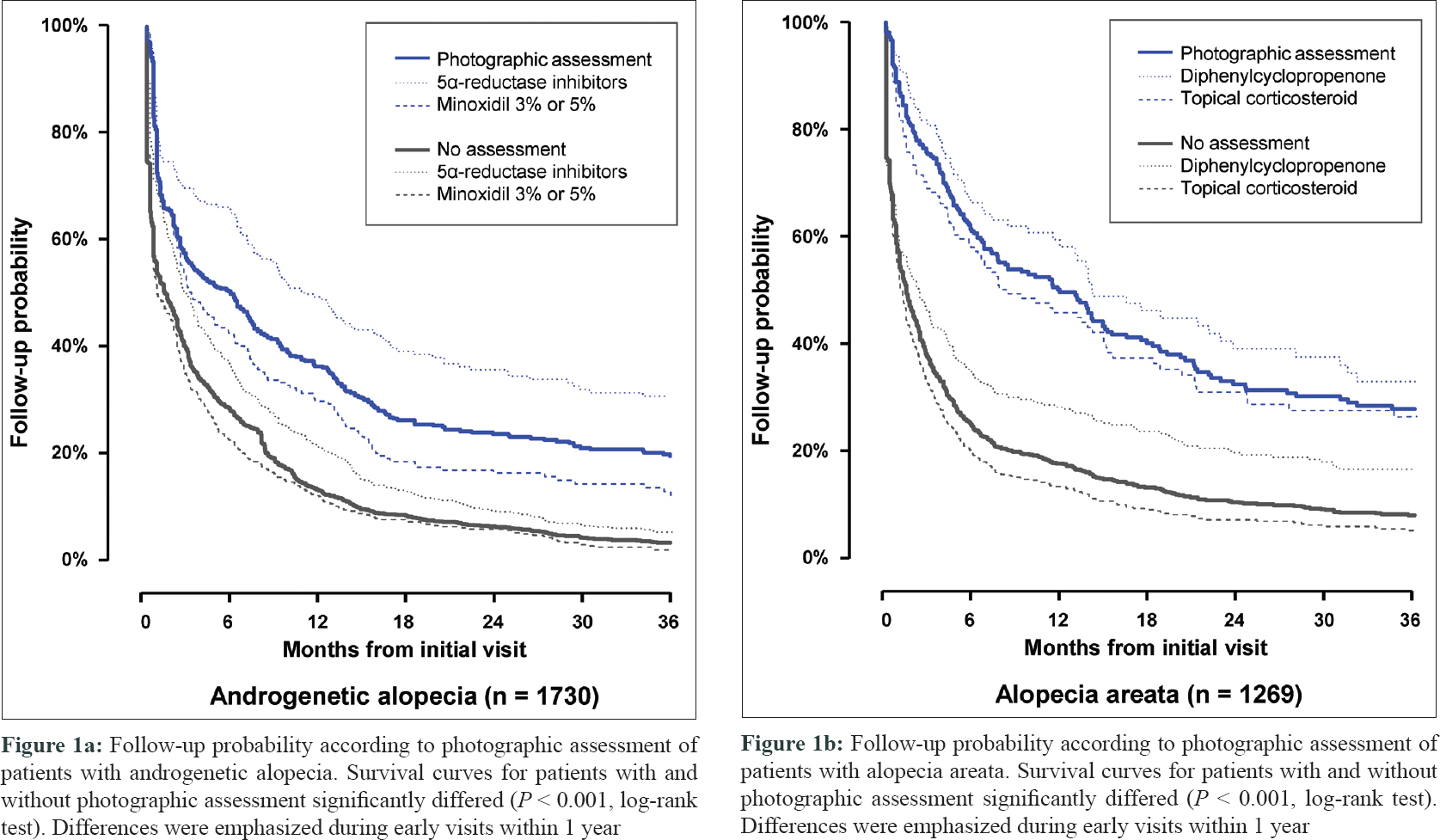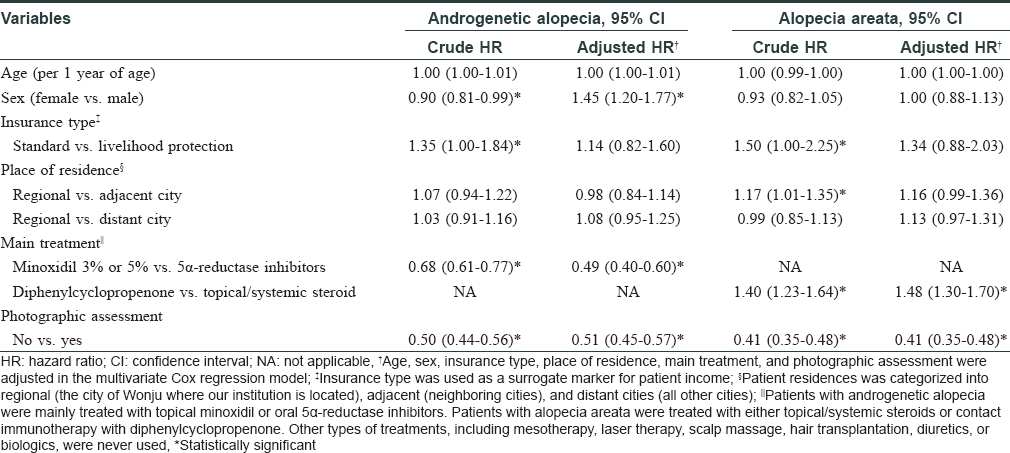Translate this page into:
Photographic assessment improves adherence to recommended follow-up in patients with androgenetic alopecia and alopecia areata: A retrospective cohort study
Correspondence Address:
Won-Soo Lee
Department of Dermatology and Institute of Hair and Cosmetic Medicine, Yonsei University Wonju College of Medicine, Ilsan-ro 20, Wonju, Gangwon 26426
Korea
| How to cite this article: Lee S, Lee H, Lee CH, Lee WS. Photographic assessment improves adherence to recommended follow-up in patients with androgenetic alopecia and alopecia areata: A retrospective cohort study. Indian J Dermatol Venereol Leprol 2019;85:431-433 |
Sir,
Androgenetic alopecia (AGA) and alopecia areata (AA) are the commonest causes of hair loss. Despite the availability of several therapeutic options, prognosis is unpredictable in many cases.[1],[2] As a result, patient dissatisfaction with treatment usually diminishes the adherence to recommended follow-ups. Accordingly, many institutions implement adjuvant interventions or offer detailed counselling and assessments to improve patient compliance. In March 2012, our institution implemented a system involving gross photography and phototrichographic (trichoscopic) analysis for objective assessment of results at each visit and improving patient communication.[3] This resulted in improved patient satisfaction and enhanced treatment compliance.[4] This study aimed to investigate the role of photographic assessment and consultation on patient adherence to recommended follow-ups.
This retrospective cohort study was approved by the institutional review board of our institute. We recruited new patients with AGA or AA who visited our clinic between January 2004 and December 2016. Electronic medical records were reviewed for demographics, place of residence, insurance type, and main treatment type. All patients visiting after March 2012 underwent baseline photographic assessment and during each subsequent follow-up, regardless of clinical characteristics and severity. The phototrichogram detected the amount and thickness of hair in patients with AGA and the presence of tapered, broken, or short vellus hair in patients with AA to assess disease activity.[2] Survival analysis and Cox regression analysis were performed to compare follow-up probability and risk before and after implementation of the photographic system. Exclusion criteria included patients who had verbal consultation alone and those failing to return within 366 days from the latest visit. However, patients who did not make a further appointment with our agreement because of complete remission of the disease or their personal circumstances such as move were not considered loss to follow-up.
A total of 2,999 patients were analyzed [Figure - 1]. The 1-year follow-up probability was 35.8% in patients with AGA who underwent photographic assessment [Figure - 1]a; 48.4% in the 5α- reductase inhibitor-treated group and 29.3% in the minoxidil-treated group]. However, the probability was only 13.5% in those without photographic assessment (22.3% in the 5α- reductase inhibitor-treated group and 12.7% in the minoxidil-treated group). In patients with AA, the 1-year follow-up probability was 50.0% [Figure - 1]b; 59.6% in the diphenylcyclopropenone-treated group and 45.4% in the topical corticosteroid-treated group] and 16.3% (27.9% in the diphenylcyclopropenone-treated group and 13.1% in the topical corticosteroid-treated group) in the groups with and without photographic assessment respectively. Patients who underwent photographic assessment had a significantly lower risk of being lost to follow-up [Table - 1]; adjusted hazard ratio: 0.51 in patients with AGA, 0.41 in patients with AA].
 |
| Figure 1: |

Our results indicate that photographic assessment independently reduces the risk of loss to follow-up/attrition to a significant extent, maximally within 1st year of treatment. Several previous investigations have also reported improvements in recommended follow-up rates with the introduction of an institutional program.[5] This suggests the importance of psychological support aided by adjuvant modalities. Female patients with AGA, as well as those treated with minoxidil, had a higher risk of follow-up loss in crude analysis, possibly due to easy availability of minoxidil over-the-counter. Interestingly, the lower risk of attrition in patients with AA treated with diphenylcyclopropenone emphasizes the importance of physician-dependent interventions.
However, this study had several limitations. First, we compared two non-contemporaneous groups. Adherence could be affected by the treatment method or notification system for pending appointments. However, there were no significant changes in prescriptions during the study period, and the reminder notification system had been implemented prior to the beginning of our study. Second, baseline disease severity could not be standardized between the two groups since objective measurements were lacking in patients who did not undergo photographic assessment. Finally, as reasons for follow-up loss were not assessed, some patients who underwent complete remission may have been considered lost to follow-up. Nevertheless, this study included a large sample size of patients; thus significant selective bias has been avoided. All the willing patients were subjected to objective assessment irrespective of disease severity or clinical characteristics. Therefore, to improve overall therapeutic outcomes, it may be beneficial to provide photographic assessment for patients with hair loss.
Financial support and sponsorship
Nil.
Conflicts of interest
There are no conflicts of interest.
| 1. |
Adil A, Godwin M. The effectiveness of treatments for androgenetic alopecia: A systematic review and meta-analysis. J Am Acad Dermatol 2017;77:136-41.e5.
[Google Scholar]
|
| 2. |
Lee S, Lee WS. Management of alopecia areata: Updates and algorithmic approach. J Dermatol 2017;44:1199-211.
[Google Scholar]
|
| 3. |
Blume-Peytavi U, Blumeyer A, Tosti A, Finner A, Marmol V, Trakatelli M, et al. S1 guideline for diagnostic evaluation in androgenetic alopecia in men, women and adolescents. Br J Dermatol 2011;164:5-15.
[Google Scholar]
|
| 4. |
Park SY, Lee WS. Impact of phototrichogram education on satisfaction of patients with androgenetic alopecia in clinical practice. J Dermatol 2014;41:773-4.
[Google Scholar]
|
| 5. |
Battaglia TA, Roloff K, Posner MA, Freund KM. Improving follow-up to abnormal breast cancer screening in an urban population. A patient navigation intervention. Cancer 2007;109:359-67.
[Google Scholar]
|
Fulltext Views
3,388
PDF downloads
1,250





